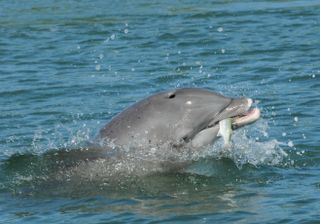
The stomach contents of bottlenose dolphins that wash ashore accurately reflect the usual diet of healthy animals, new research suggests.
It might seem intuitive that stranded animals' stomach contents can reveal the typical diet of that species, but scientists have hotly debated the issue.
"Lots of people have criticized the use of data from stranded animals as potentially being unrepresentative, because they're often sick animals," said Graham Pierce, a marine biologist at the University of Aberdeen, who was not involved in the study.
The findings, published today (April 30) in the journal Biology Letters, lay to rest that criticism, at least for bottlenose dolphins. [Deep Divers: A Gallery of Dolphins]
Diet mysteries
Beached whales and dolphins have often provided some of the best insights into the feeding habits of cetaceans. These sea dwellers often live far off the coast in the ocean depths, and their elusive nature makes them difficult to study while alive.
But because dolphins that wash ashore are usually sick, and far from their hunting grounds in the open ocean, scientists have questioned whether their stomach contents accurately reflect the healthy-animal diet.
Sign up for the Live Science daily newsletter now
Get the world’s most fascinating discoveries delivered straight to your inbox.
To find out, Glenn Dunshea, a marine biologist at the Ecological Marine Services in Australia, and his colleagues captured bottlenose dolphins from Sarasota Bay, Fla., for occasional health checkups.
During the checkups, Dunshea gathered stomach juices and feces from 18 dolphins.
"I was essentially the only guy on the boat that got excited when the dolphin did its business," Dunshea said.
The researchers used DNA analysis to identify the prey the dolphins consumed. They then compared that with 22 years' worth of data on the stomach contents of stranded dolphins.
The stranded dolphins' stomach contents mirrored the foods healthy dolphins were eating.
Passive listening
In particular, the dolphins ate a lot of soniferous fish, or fish that makes sounds, such as gulf toadfish, Dunshea said.
That lends credence to the hypothesis that the dolphins didn't send out sonar pings to first find prey.
"They're probably listening for prey, they're being quiet, and then when they find prey and can localize it to a very small area, they may be using their sonar to finalize the kill, so to speak," Dunshea told LiveScience.
Beyond dolphins
While the findings are useful for these particular bottlenose dolphins, which tend to hug the shore, they may not apply to dolphin and whale species that tend to live farther out in the open ocean, Pierce said. That's because the type of prey found near the shore could be different than that in the deep ocean.
"I would be very hesitant of applying it to species which live in deep waters and occasionally strand on the coast," Pierce said.
Follow Tia Ghose on Twitter @tiaghose. Follow LiveScience @livescience, Facebook & Google+. Original article on LiveScience.com.

Tia is the managing editor and was previously a senior writer for Live Science. Her work has appeared in Scientific American, Wired.com and other outlets. She holds a master's degree in bioengineering from the University of Washington, a graduate certificate in science writing from UC Santa Cruz and a bachelor's degree in mechanical engineering from the University of Texas at Austin. Tia was part of a team at the Milwaukee Journal Sentinel that published the Empty Cradles series on preterm births, which won multiple awards, including the 2012 Casey Medal for Meritorious Journalism.
Most Popular




